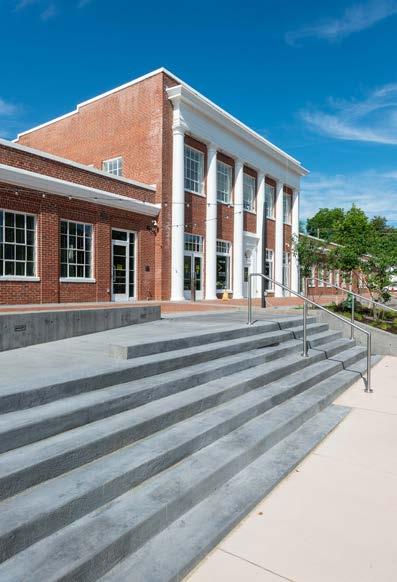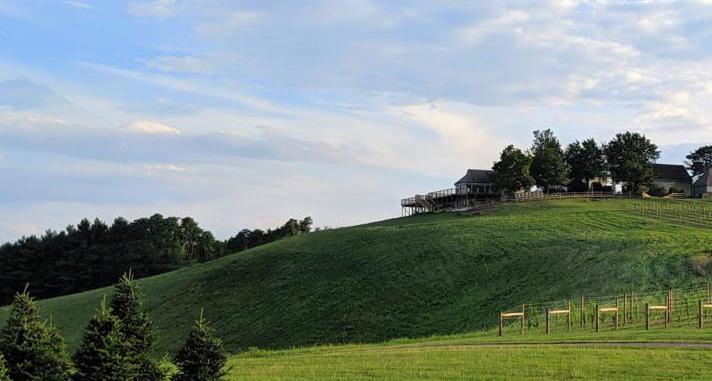The Dish
High time
The start of something new for Virginia winemaking By Paul Ting
A
t the end of May, following the phase one reopening announcement for Virginia businesses, 12 Ridges Vineyard started welcoming visitors back to its tasting room which overlooks, wait for it...12 acres of vineyards. Like many wineries, 12 Ridges, formerly Skylark Farm and, until now, best known as a Christmas tree farm, features incredible views, outdoor seating, and availability for weddings and events. What gives this winery distinction is that the vines are planted at approximately 3,300 feet, making it the highest altitude vineyard site in the state of Virginia. At higher altitudes, cooler temperatures allow grapes to express themselves differently, with generally less sugar and more acid, producing wines lower in alcohol and brighter and livelier in taste. And there are other benefits to high altitude winemaking (like more direct and concentrated sunlight, larger differences between daytime and nighttime temperatures, and slopes
14 Knife&Fork Summer
allowing cool air and water to drain), but there are also a few challenges. Some sites are on the edge of being too cold for vines to grow. And steep slopes can make farming difficult, requiring manual labor and increasing costs. Still, it may be worth the risk. Joy Ting (this writer’s wife), research enologist and coordinator of the Winemakers Research Exchange, explains, “Virginia is a big state and we are still a wine region that is exploring as we evolve and mature. Are we planting in the right places? Are we ignoring areas that don’t fit preconceived notions and missing out on quality wine?” Jake Busching, who has grown grapes in Virginia for over 20 years, was responsible for planting 12 Ridges. He’s also the consultant at Stone Mountain Vineyards, where he was hired to replant its vineyards in 2017. Stone Mountain sits at an elevation of 1,750 feet and was initially planted in the mid-1990s with French varieties, the fashion at the time. Some of these did well, but others struggled in the cooler climate. So Busching worked with Stone Mountain owners Jim and Deanna Gephart to put in pinot noir and pinot gris, varieties known to thrive in cooler conditions. Busching says, “I’ve been steadfast about not putting red grapes (cabernet sauvignon, cabernet franc, merlot) above that. But at that elevation, as Ankida Ridge has proven, you can do pinot noir...and chardonnay is beautiful.” Also at 1,750 feet, Ankida Ridge has earned a reputation for perhaps the best pinot noir in Virginia. Owners Christine and Dennis Vrooman, who first planted in 2008, recognized their site
“It’s my goal to become the premier cool climate vineyard in the state.” Craig Colberg would be well-suited to pinot noir and chardonnay. 12 Ridges owner Craig Colberg draws inspiration from them, “I’ve tasted pinot noir from Ankida. It’s excellent. I aspire to pinot like theirs.” For 12 Ridges, Busching worked with Colberg to develop a vision of what would be possible at his extremely high site. Busching focused on cold-hardy varieties like chardonnay, pinot gris, riesling, and pinot noir, and he says he planted intentionally for sparkling wine. Most agree sparkling wine has great potential for Virginia, and Busching sees it as a unique opportunity for 12 Ridges. “Sparkling wine could be a game changer because it’s a largely untapped market with high consumer demand,” he says. “12 Ridges has the potential to be the best sparkling wine in Virginia.” Among those on Colberg’s team are winemaker Ben Jordan, whose labels include Early Mountain Vineyards, Lightwell Survey, and his family’s Midland Construction. In addition, Tim Jordan, who grows grapes on the Jordan family farm, will be the vineyard manager going forward. Jordan says he embraces the challenge of learning about growing at 12 Ridges. “What remains to be seen is whether they are too high and too exposed to winter cold...What ripens and when it ripens will be fun to find out.”




